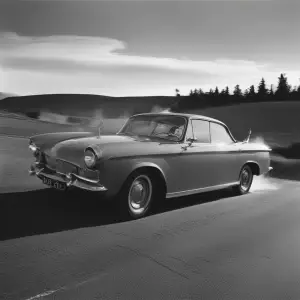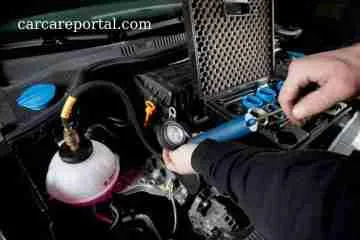Car Shaking Out of Nowhere? Check These Possible Causes

Introduction: Why is your car shaking?
Why is your car shaking all of a sudden? There are a few possible reasons for those vibrations coming from your vehicle.
Worn out tires
If your tires are bald or unevenly worn down, it can cause your car to shake, especially at higher speeds. New tires may be the simple fix here. An unbalanced tire can also lead to shaking, in which case you’ll need to get your tires rotated and rebalanced.
Faulty brakes
If your brake pads or rotors are worn down or damaged, it can cause your car to shake when braking at high speeds. Have your brakes checked by a mechanic right away – this is not something you want to put off! They may need replacement, which will eliminate the shaking and ensure your safety.
Wheel alignment or balance issues
If your wheels are out of alignment or balance, it can result in shaking and vibration. Wheel alignment and tire balancing are easy services to have done at most repair shops or tire stores. They’ll get your wheels aligned and balanced, correcting the problem and ensuring smooth driving.
Other possible causes
Other culprits could be:
- Loose or worn out suspension components like ball joints, tie rods or control arm bushings.
- Engine problems like a bad spark plug, fuel injector issue or ignition coil.
- Drivetrain issues such as a faulty universal joint or CV axle.
The bottom line is if your vehicle is shaking for no apparent reason, don’t ignore it. Have it checked by a mechanic to determine the cause and get the necessary repairs done. Your safety and peace of mind depend on it!
Reason 1 – Engine Misfires Causing the Car to Shake
If your car suddenly starts shaking for no apparent reason, it could be engine misfires causing the vibration.###
Engine misfires happen when one or more cylinders in your engine fail to ignite the air-fuel mixture properly. This interrupts the engine’s power and causes it to shake or stumble. The shaking will be more pronounced at idle since the engine has to work harder to keep the vehicle running.
Some possible causes of engine misfires include:
- Faulty spark plugs or ignition coils: These components provide the spark that ignites the air-fuel mixture in the cylinders. If they malfunction, misfires result.
- Vacuum leak: A vacuum leak allows too much air into the engine, upsetting the air-fuel ratio. This can lead to misfires and a rough idle.
- Bad fuel injector: Fuel injectors spray fuel into the cylinders. A clogged or malfunctioning injector may not provide enough fuel, causing the cylinder to misfire.
- Other issues: Things like a bad sensor, clogged air filter, low fuel pressure, or compression problems can also potentially trigger engine misfires and vibrations.
The check engine light may come on if the misfires are bad enough. It’s best to have the vehicle scanned for diagnostic trouble codes to determine the exact cause. Engine misfires can damage the catalytic converter and reduce performance, so get it checked out as soon as possible. With the right diagnosis and repair, you’ll have your ride running smoothly again in no time.
Reason 2 – Worn Out or Unbalanced Tires
Your tires are what connect your vehicle to the road, so if they’re worn out or unbalanced, it can cause your car to shake.
Worn Out Tires
After years of use, your tires will start to wear down and lose tread. Bald or nearly bald tires won’t grip the road properly, which can cause vibration and shaking, especially at higher speeds. If your tires have uneven tread wear, meaning the inner or outer edges are more worn than the rest of the tread, that can also lead to shaking and vibration.
It’s a good idea to have your tires rotated every 5,000 to 10,000 miles to prevent uneven tread wear. But if your tires already show signs of severe or uneven wear, it’s best to replace them. New tires will eliminate the shaking and provide much better handling, braking, and safety.
Unbalanced Tires
Your tires and wheels also need to be properly balanced to spin smoothly at high speeds. An unbalanced tire means the weight isn’t distributed evenly, so as the tire rotates, the heavy spot causes a shuddering effect. Unbalanced tires tend to shake the steering wheel and seat at certain speeds, typically between 50 to 70 mph.
To fix an unbalanced tire, have the tires removed from the wheels and rebalanced using wheel balancing weights. A tire shop can rebalance your tires quickly and easily. Balancing your tires should eliminate any shaking or vibration from unbalanced tires and allow for a smooth ride once again.
Other possible reasons for a shaking vehicle include:
• Faulty wheel bearings: Wheel bearings help the wheels spin smoothly. Faulty or worn bearings can cause the wheels to wobble, resulting in shaking.
• Bent wheel: If one of your wheels has become bent or dented from a pothole or curb impact, it won’t spin properly and can cause shaking. The wheel will need to be repaired or replaced.
• Drivetrain issues: Problems with your vehicle’s axles, CV joints, or transmission can also lead to shaking and vibration at certain speeds. It’s best to have your vehicle inspected by a mechanic to determine the exact cause.
Reason 3 – Issues With the Suspension System
If your car is shaking while driving, it could indicate a problem with your suspension system. The suspension consists of shock absorbers, struts, control arms, and other components that connect the vehicle frame to the wheels. When these parts start to wear out or fail, you’ll feel vibrations and shaking coming through the steering wheel, seat, and floor of the car.
Faulty Shock Absorbers or Struts
Shock absorbers and struts are designed to dampen the bouncing movement of your wheels over imperfections in the road. As they start to fail or leak fluid, they lose their ability to absorb these impacts. You’ll feel the shaking and rattling as the wheels hit bumps. The handling and cornering of your vehicle will also start to feel “loose” or sloppy.
Worn Control Arm Bushings
Control arms connect the suspension to the frame of your vehicle. Bushings fit over the control arms to allow some movement while preventing excess play. When these bushings wear out, the control arm is loosened, and the wheel is no longer held firmly in the correct position. This results in shaking, rattling over bumps, and difficulty steering.
Ball Joint Wear
Ball joints connect the control arms to the steering components. They need to be tight to allow proper wheel positioning and steering control. Loose or worn ball joints will produce shaking and make it difficult to steer, as the front wheels wobble and won’t stay aligned properly.
Bent or Damaged Suspension Components
Major impacts can potentially bend or damage suspension parts like control arms, tie rods or stabilizer bars. If any of these components become bent or warped, it will seriously affect wheel alignment and produce shaking and vibrations. This type of damage requires replacement of the affected parts to correct.
In summary, the most likely reasons your vehicle is shaking are worn or failing suspension components like shocks, struts, control arm bushings, ball joints or damaged stabilizer bars. It’s best to have the suspension system checked by a certified mechanic to diagnose the problem and perform necessary repairs to eliminate the shaking and ensure safe driving.
Reason 4 – Problems With Brakes Causing Vibrations
One possible reason your car may be shaking is an issue with your brake pads or rotors. Your brakes are responsible for slowing and stopping your vehicle, so any problems with them can cause vibrations.
Worn Out or Damaged Brake Pads
Brake pads are the components in your brake system that press against the rotor to slow your wheels. Over time and with use, brake pads naturally wear down. If they wear down too much, they won’t grip the rotor effectively, which can lead to shaking and vibrations. It’s a good idea to have your brake pads inspected regularly and replaced when they’re down to about 1/4 of an inch thick.
Signs your brake pads may need replacement include:
- Squealing or grinding noises when braking
- The brake pedal feeling loose or spongy
- The brake warning light coming on
Warped or Damaged Brake Rotors
Brake rotors are the circular components your brake pads clamp down on to slow the wheels. Rotors can become warped or damaged over time, preventing them from spinning smoothly. This results in vibrations and shaking that you’ll feel through the brake pedal, steering wheel, and floor of the vehicle.
Some signs your rotors may need replacement include:
- Vibrations or shaking felt during braking
- The steering wheel or brake pedal pulsating when braking
- Scratches, grooves or dents on the surface of the rotors
- The vehicle pulling to one side when braking
To determine if your brake pads or rotors are the culprit, have your brakes inspected by a certified mechanic. They can test drive your vehicle to feel the vibrations firsthand, and perform diagnostics to check the condition of your brake pads and rotors. Replacement of brake pads and rotors may be necessary to eliminate the shaking and ensure safe braking.
Driving with worn out or damaged brake components is dangerous, so get your brakes checked right away if you notice any signs of vibrations or strange noises. It’s not worth risking your safety or the safety of others on the road.
Reason 5 – Driveline Components Causing Vibrations
Have you noticed your car shaking or vibrating recently for no apparent reason? It could be an issue with one of your driveline components. The driveline refers to the parts that transfer power from the engine to the wheels, including the transmission, drive shafts, axles, CV joints, and differential. If any of these components are worn, damaged or out of balance, it can cause noticeable vibrations.
CV Joints
CV joints connect the drive shafts to the front wheels, allowing them to move freely as the steering wheel turns. Over time, the joints can become worn or damaged, causing vibrations at certain speeds. You may hear clicking or popping sounds when turning. It’s best to have the CV joints inspected and replaced if needed.
Drive Shafts
The drive shafts, also known as axles, transfer power from the transmission to the wheels. If a drive shaft becomes bent, damaged or unbalanced, it will cause vibrations throughout the vehicle. Drive shaft issues often get worse over time and at higher speeds. It’s not safe to drive with a faulty drive shaft, so have it checked by a mechanic right away.
Differential
The differential allows the rear wheels to spin at different speeds when turning, which is important for control and stability. If the differential breaks or fails, it can lead to vibrations, especially when accelerating. You may also notice the vehicle pulls to one side. It’s critical to have differentials serviced to avoid unsafe driving conditions.
Other potential culprits for driveline vibrations include:
- Worn or damaged wheel bearings – Allow the wheels to spin smoothly, vibrations when turning or at high speeds.
- Bad universal joints – Connect sections of the drive shaft, vibrations throughout the vehicle.
- Faulty transmission – Issues with the transmission can also lead to shaking and vibrations.
If your vehicle is shaking or vibrating for unknown reasons, have the driveline inspected as soon as possible. While driveline components are complex, a certified mechanic has the proper tools, training and experience to diagnose issues accurately and perform necessary repairs or replacements to get your vehicle running safely and vibration-free again.
Reason 6 – Issues With Motor Mounts
If your car starts shaking unexpectedly, it could indicate issues with your motor mounts. Motor mounts attach the engine to the frame of the car, reducing vibration and ensuring stability. Over time, the rubber or fluid in the mounts can break down, allowing the engine to shake and rattle.
Inspect the Motor Mounts
To check for bad motor mounts, have someone start the engine while you inspect the mounts. Look for torn, cracked or deteriorated rubber mounts. For hydraulic mounts, check for any visible leaking fluid. With the engine idling, see if the engine is wobbling or shaking excessively. If the mounts are in good shape but the engine is still shaking, it could point to problems with the mounts.
Other Symptoms of Failing Motor Mounts
In addition to vibration at idle, other signs of bad motor mounts include:
- Clunking or knocking noises when accelerating
- The vehicle pulling to one side when braking
- Increased vibration felt through the steering wheel, floorboards or seat
- The engine tilting or twisting out of position
Replacing Motor Mounts
Replacing bad motor mounts will eliminate the shaking and vibration, and prevent further damage. For most vehicles, motor mount replacement is a straightforward job for a mechanic. They will support and lift the engine to remove and replace the worn mounts. For more complex mounts, they may need to remove additional components to gain access.
The cost to replace motor mounts varies but typically ranges from $200 to $1000 for parts and labor, depending on the vehicle make and model. While it can be an expensive repair, failing to replace bad mounts promptly can lead to further damage like transmission or drivetrain issues. It’s best to have any vibration or shaking checked as soon as possible to avoid costly repairs down the road.
If your once smooth-riding vehicle has turned into a rumbling, rattling mess, don’t ignore it. Get those motor mounts inspected. With new mounts installed, you’ll be back to enjoying a quiet, comfortable ride in no time.
Reason 7 – Damaged Wheels or Loose Lug Nuts
Reason 7 – Damaged Wheels or Loose Lug Nuts
If your car suddenly starts shaking for no apparent reason, it could be a sign of damage to your wheels or loose lug nuts. The lug nuts are what securely fasten your wheels to the wheel hubs and axles. If they become loose or fall off, it allows the wheel to wobble as you drive, creating a shaking sensation.
Check your lug nuts
The first thing you should do is have someone check your lug nuts to ensure they are tight while the wheels are still on the ground. If multiple lug nuts are loose or missing on one wheel, do not drive the vehicle – tow it to a repair shop instead. Driving with loose or missing lug nuts can cause the wheel to fall off, creating a life-threatening situation.
Inspect wheels for damage
If the lug nuts seem tight but the shaking persists, you may have damage to one or more of your wheels. Some signs of wheel damage include:
- Cracks or dents in the wheel rim
- Bulges or warping of the wheel rim
- Missing wheel weights (used to balance the wheels)
- Excessive wear on one part of the tread (can indicate wheel is out of balance)
Wheel damage will require replacement of the damaged wheel to fix the shaking and ensure safe driving. It’s best to have the wheels inspected by a mechanic to determine if replacement is needed. They can also rebalance or realign the wheels if needed to correct the shaking.
Driving with damaged or unbalanced wheels can be unsafe and lead to loss of control or blowouts. If you experience shaking in your vehicle, it’s best to have the wheels and lug nuts checked as soon as possible to avoid potential problems and ensure smooth, dependable performance from your wheels. Regular inspections of your lug nuts and wheels at each oil change or tire rotation is also a good preventative measure.
Conclusion
So there you have it, the most common reasons why your car might start shaking out of the blue. Don’t panic – in many cases it’s an easy fix, whether it’s balancing your tires, replacing your air filter or tightening your alternator belt. The key is to get your car checked out as soon as you notice the shaking so you can get back to smooth sailing and avoid bigger problems down the road. Your faithful vehicle has been there for you through all of life’s adventures, so show it some love in return and take it into the shop. It will be worth it for the peace of mind and open road ahead!
















No Comment